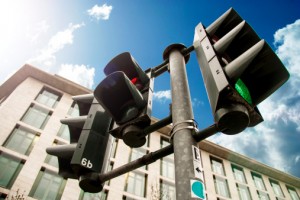Traffic signals can help make intersections safer for pedestrians, especially when used appropriately.

Parameters of the Study
The study was based on data from New York City, a metropolitan area with a reputation for some of the worst traffic and largest volume of pedestrians in the country. The researchers collected accident data from intersections for five years before a new signal was installed and for two years afterwards. This allowed them to compare the percent change in accident rates before and after the signals were installed. Four types of signals were identified for study:
The Basic Signal: The first thing the researchers looked at was the level of improvement in accident prevention when a simple traffic light was installed at an intersection that had previously been a 4-way stop. They discovered that this type of signal helped decrease car accident rates, but pedestrian accident rates continued to rise after installation, albeit at a slower rate than before.
Split-Phase Timing: This type of traffic signal introduces an extra phase where cars are not permitted to turn so pedestrians can cross. A protected turn lane must be provided for this type of signal to work, but if this is available pedestrians will see significant improvement in protection. The researchers found that pedestrian accidents decreased at a rate of 39 percent after installation of split-phase signals.
The Barnes Dance: Sometimes known as a pedestrian scramble signal, this type of traffic light stops all vehicle traffic and allows pedestrians to cross in any direction, even diagonally. Pedestrians need to be more patient as it takes longer for the light to cycle through, but in New York this type of signal delivered a 51 percent decrease in the pedestrian accident rate.
Increased Pedestrian Cycle: This type of traffic signal provides extra time for pedestrians to cross. It is ideal for situations where pedestrians may have to cross multiple lanes of traffic, and may also be helpful near hospitals or senior centers where pedestrians are likely to be moving more slowly than normal. Researchers found that pedestrian accidents decreased at a rate of 50 percent with this type of signal installed.
Why Traffic Signal Design Matters
If you’ve been involved in a pedestrian accident, it’s important to consider the possibility that the municipality may be liable based on poorly chosen, inadequately maintained, or malfunctioning traffic signals. For example, if the signal was not configured to allow sufficient time for crossing or if the “don’t walk” signal malfunctioned and you were injured as a result, the municipality could be responsible for a portion of your damages. Contact an expert pedestrian accident attorney like Michael A. Kahn for detailed advice about your particular case.

